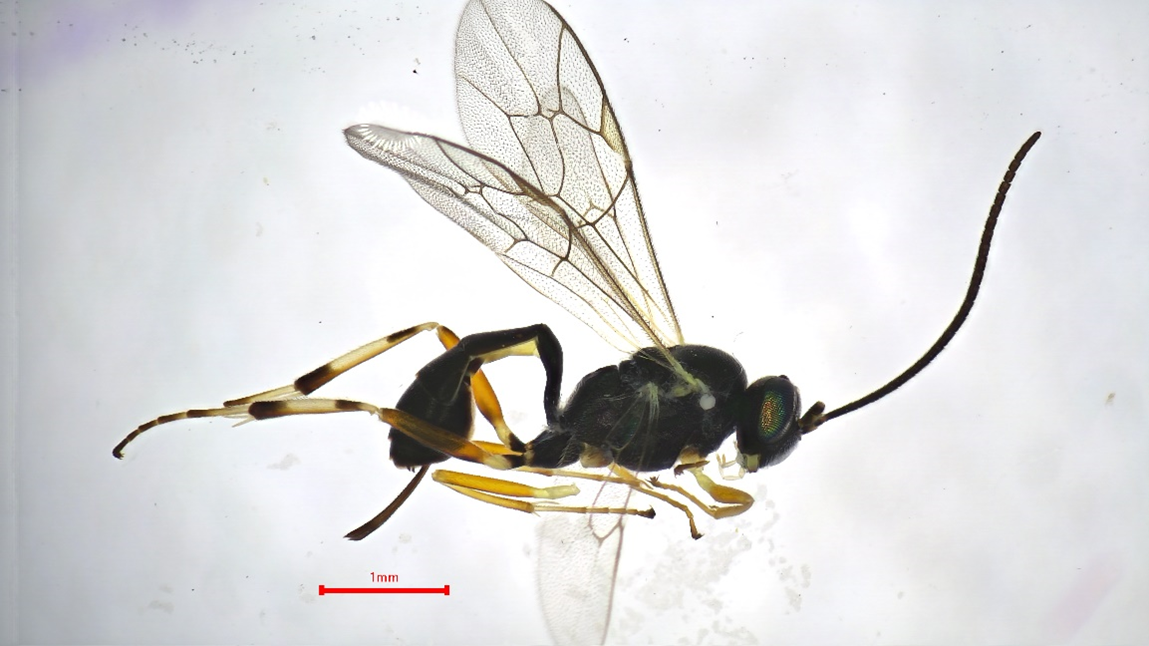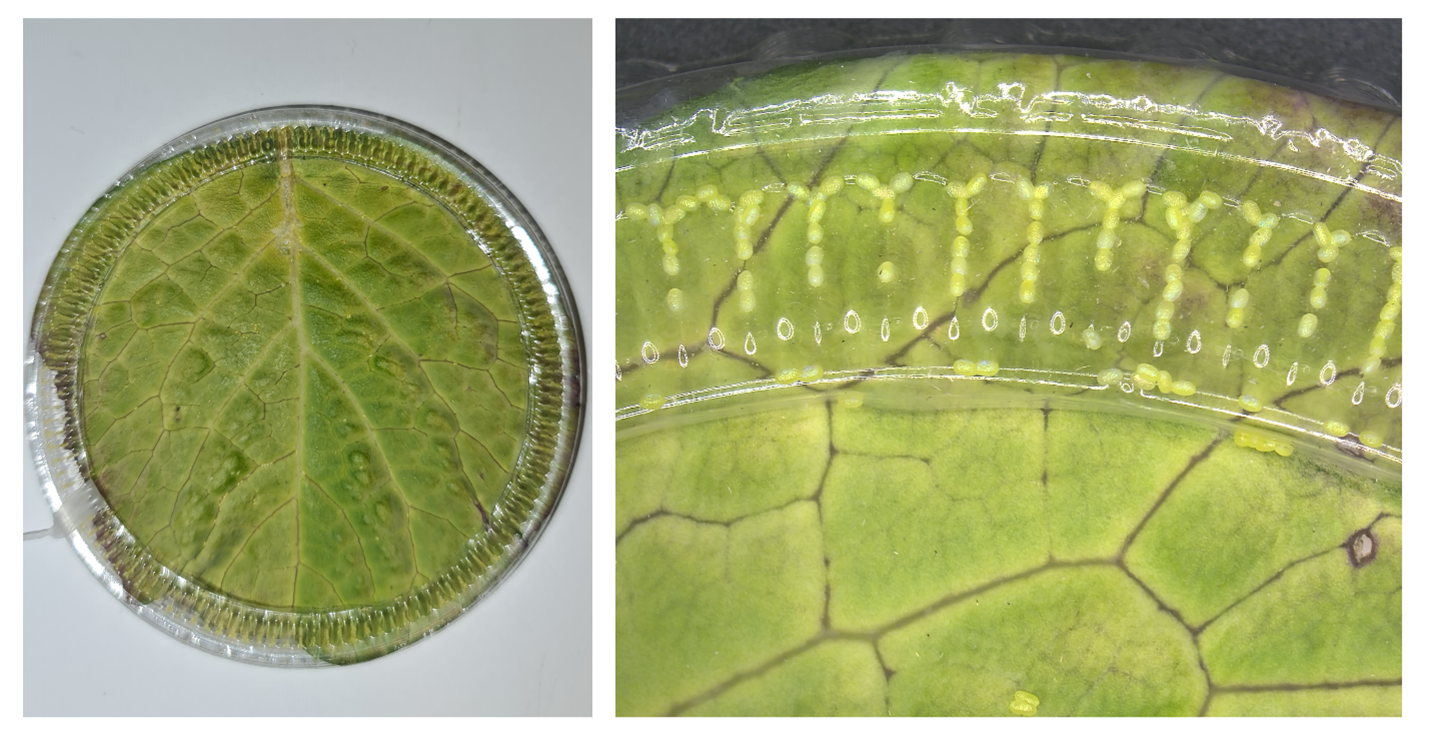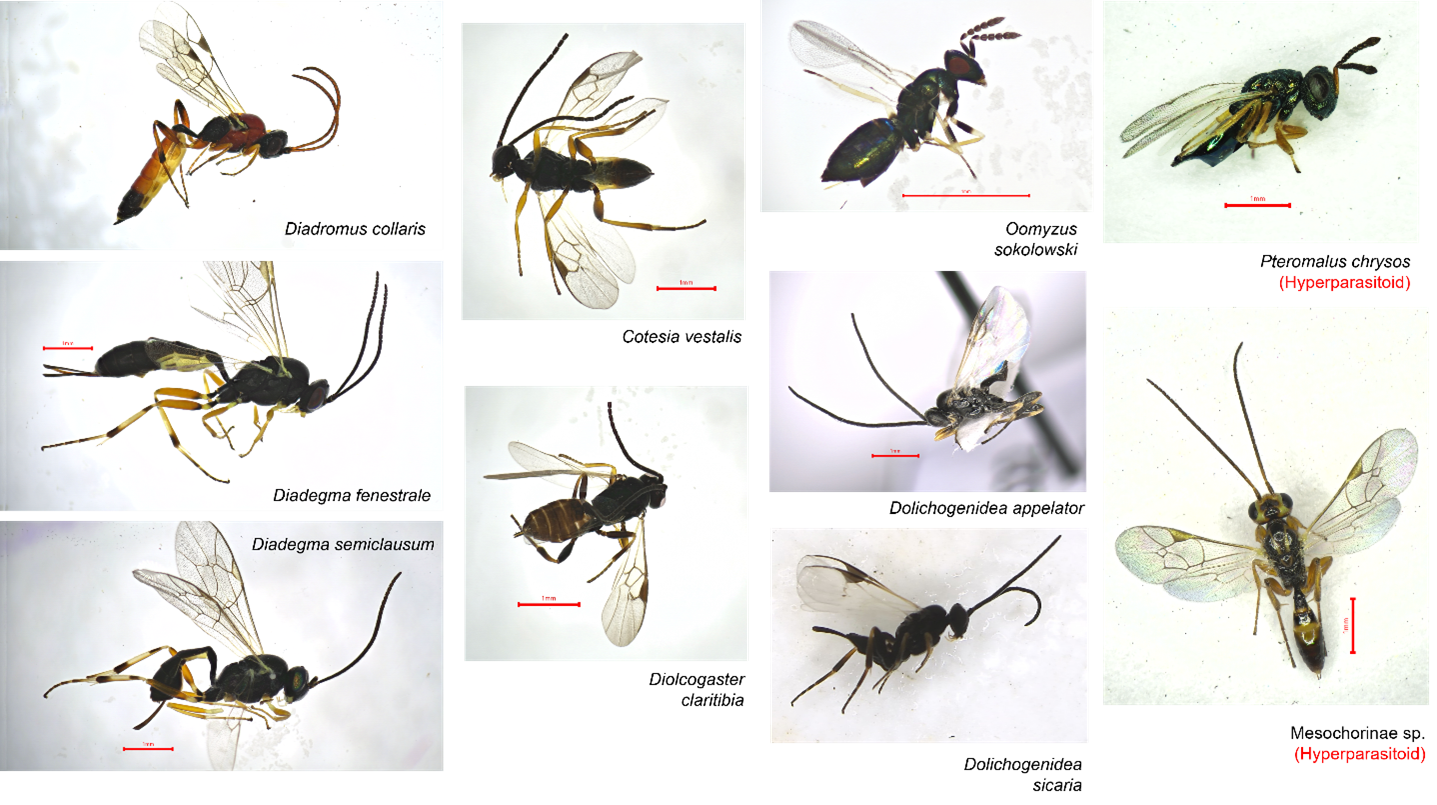EBCL and California Department of Food and Agriculture Collaboration on Biological Control of the Diamondback Moth
A Major Pest of Cole Crops
By Gaylord Desurmont, Marie-Claude Bon and Javid Kashefi, European Biological Control Laboratory (EBCL)
The Diamondback moth Plutella xylostella (DBM) is a major pest of cultivated crucifers, particularly Brassica crops (cabbage, brussels sprouts, broccoli, kale, canola…). This true cosmopolitan pest causes problems for Brassica growers worldwide, with an estimated annual cost of 4-5 billion $US for growers. Chemical control has been the main management strategy to regulate DBM populations, but the pest has developed resistance to the main classes of synthetic insecticides that are used for its control. Resistance problems have led to an increase in the quantities of insecticides applied, which in turn have given rise to even higher insecticide resistance, higher levels of crop damage, and increased concerns about pesticide residues and their impact on human health and the environment. The limitations of chemical control have urged growers to find alternative pest control solutions, including biological control and integrated pest management.
 Young diamondback moth larvae feeding on a mustard leaf.
Young diamondback moth larvae feeding on a mustard leaf.
 Collection of diamondback moth larvae and pupae in an organic cabbage field in the south of France.
Collection of diamondback moth larvae and pupae in an organic cabbage field in the south of France.
Biological control relies on the natural regulation of pest populations by their natural enemies. These natural enemies can be generalist predators such as ladybeetles, or parasitoids, which are in general more specialized, or even entomopathogens (bacteria, fungi, nematodes or viruses specific to insects). Classical biological control programs rely on the introduction of natural enemies originating from the native range of the target pest to its invasive range in order to re-establish a natural equilibrium that was lost in the invasion process. DBM is a particularly promising target for classical biological control because many natural enemies are known to attack its different life stages worldwide. However, several challenges remain. First, there is no clear consensus on the origin of DBM. Populations of DBM from different geographical areas have considerably mixed over time and adapted to their local environments, making the extent of the native range of this pest difficult to delimit. Secondly, the existence of many natural enemies worldwide does not guarantee that one of them could be introduced and used as a biological control agent in the USA. Prospective biological control agents must meet several critical conditions to be considered adequate for introduction, including: 1) high impact on the target pest, 2) high specificity (the agent must not impact non-target species), and 3) high level of adaptation to the environmental conditions of its area of introduction.
In 2022, The USDA, ARS, European Biological Control Laboratory (EBCL) started a research project on the biological control of DBM in California. This project is a collaboration between the Californian Department of Food and Agriculture biological control program (CDFA),
The EBCL particpation has the following objectives:
- To genetically characterize DBM populations and their natural enemies in different parts of Europe and Africa.
- To select a population of Diadegma semiclausum (Hymenoptera: Braconidae, a parasitic wasp that attacks DBM larvae) that is well adapted to the current Californian DBM populations.
The parasitoid D. semiclausum is a particularly promising natural enemy of DBM because of its high impact on DBM populations and high level of specificity. It has been successfully introduced and used as a biocontrol agent in several areas of the world. In the USA, another closely related species of D. semiclausum, Diadegma insulare is one of the main natural enemies of DBM.
 Diadegma semiclausum, a natural enemy of the diamondback mot
Diadegma semiclausum, a natural enemy of the diamondback mot
As of January 2023, a total of eight species of parasitoids of DBM have been collected by EBCL, mainly from cabbage fields located in France and Greece. The impact of these parasitoids on local DBM populations was high, exceeding 50% in some locations. A rearing of six populations of DBM (origins: France, the Netherlands, Greece, and the USA (x3)) and two populations of the parasitoid D. semiclausum (origins: The Netherlands and Greece) were initiated and are currently maintained at EBCL.
In 2023, these populations of D. semiclausum are being evaluated against their original DBM population and DBM populations from California, including populations that show insecticide resistance, under quarantine conditions. Several parameters of parasitoid performance will be measured to select the most suitable D. semiclausum population for use in California. Additional experiments will investigate the effects of host plant on parasitism success and the competitive interactions between D. semiclausum and D. insulare.
 Device designed to collect diamondback moth eggs and facilitate rearing under laboratory conditions. A cabbage leaf is placed underneath a striated plastic cover. The right picture is a close-up of the device showing the eggs being laid along the streaks of the plastic cover.
Device designed to collect diamondback moth eggs and facilitate rearing under laboratory conditions. A cabbage leaf is placed underneath a striated plastic cover. The right picture is a close-up of the device showing the eggs being laid along the streaks of the plastic cover.
The full list of parasitoids of DBM collected by EBCL in 2022 is as follows:
France
- Diadegma semiclausum (Ichneumonidae)
- Diadegma fenestrale (Ichneumonidae)
- Diadromus collaris (Ichneumonidae)
- Cotesia vestalis (Braconidae: Microgastrinae)
- Dolichogenidea sicaria (Braconidae: Microgastrinae)
- Diolcogaster claritibia (Braconidae: Microgastrinae)
Greece
- Diadegma semiclausum (Ichneumonidae)
- Oomyzus Sokolowski (Chalcidoidea: Eulophidae)
- Dolichogenidea appellator (Braconidae: Microgastrinae)
 Overview of the eight parasitoid species of Diamondback moth collected by EBCL USDA ARS in 2022, as well as two species of hyperparasitoids (right pictures).
Overview of the eight parasitoid species of Diamondback moth collected by EBCL USDA ARS in 2022, as well as two species of hyperparasitoids (right pictures).
The European Biological Control Laboratory (EBCL) was established in 1991 near Montpellier, France. EBCL was created by the merger of the former European Parasite Laboratory, established in Paris in 1919, and the Biological Control of Weeds Laboratory in Rome. EBCL has a satellite laboratory in Thessaloniki, Greece. As the only USDA ARS-operated laboratory outside the United States, EBCL develops biological control technologies which can be used to suppress invading weeds and insect pests of Eurasian origin. EBCL researchers do this by searching for natural enemies (insects, mites, and pathogens) in their native habitat, determining their identity, testing their host specificity and potential impact in laboratory and field experiments, and shipping promising organisms to the U.S. for further testing as biological control agents. EBCL collaborates with scientists in many countries in Europe, Asia, and Africa to explore in regions of origin of the target weeds and insects.
